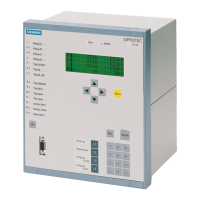2 Functions
160
7SD5 Manual
C53000-G1176-C169-1
There are two ways of blocking Z1. If the device operates in differential protection
mode, zone Z1 can be blocked by setting a parameter (address 1533 Z1 blkd by
diff). Another way of blocking the zone is to set a binary input (No 3610 „>BLOCK
Z1-Trip“).
Controlled zone
Z1B
The overreaching zone Z1B is a controlled zone. The normal zones Z1 to Z5 are not
influenced by Z1B. There is therefore no zone switching, but rather the overreaching
zone is activated or deactivated by the corresponding criteria. It can also be set in
address 1751 Op. mode Z1B to Forward or Reverse. If this stage is not required,
it is set to Inactive in address 1751. The setting options are similar to those of zone
Z1: address 1752 ZR(Z1B). The delay times for single-phase and multiple-phase
faults can again be set separately: T1B-1phase (address 1655) and T1B-multi-
phase (address 1656).
Zone Z1B is usually used in combination with automatic reclosure and/or teleprotec-
tion systems. It can be activated internally by the teleprotection functions (see also
Section 2.7) or the integrated automatic reclosure (if available, see also Section 2.15),
or externally by a binary input. It is generally set to at least 120 % of the line length.
On three-terminal line applications („teed feeders“), it must be set to securely reach
beyond the longest line section, even when there is additional infeed via the tee-off
point. The delay times are set in accordance with the type of application, usually to
zero or a very small delay. When used in conjunction with teleprotection comparison
schemes, the dependence on the fault detection must be considered (refer to margin
heading „Distance Protection Prerequisites“ in Section 2.7.14.
If the distance protection is used in conjunction with an automatic recloser, it may be
determined in address 1657 1st AR -> Z1B which distance zones are released prior
to a rapid automatic reclosure. Usually the overreaching zone Z1B is used for the first
cycle (1st AR -> Z1B = YES). This may be suppressed by changing the setting of
1st AR -> Z1B to NO. In this case the overreaching zone Z1B is not released before
and during the 1st automatic reclose cycle. Zone Z1 is always released. The setting
only has an effect when the service condition of the automatic reclose function is input
to the device via binary input „>Enable ARzones“ (No. 383).
Polarization The degree of polarization with a fault-accurate memory voltage can be set in address
1771 Mem.Polariz.PhE for Ph-E loops, and in address 1773 Mem.Polariz.P-P
for Ph-Ph loops. With an unfaulted valid voltage (cross-polarization), the evaluation
factor can be set separately for Ph-E and Ph-Ph in address 1772 CrossPolarizPhE
and 1774 CrossPolarizP-P. This setting can only be changed via DIGSI
®
at Addi-
tional Settings.
These parameters have an impact on the expansion of the characteristics dependent
on the source impedance. If the parameter is set to zero, the basic characteristic is
displayed without expansion.
2.5.3.3 Settings
Addresses which have an appended "A" can only be changed with DIGSI, under Ad-
ditional Settings.
The table indicates region-specific presettings. Column C (configuration) indicates the
corresponding secondary nominal current of the current transformer.
www . ElectricalPartManuals . com
